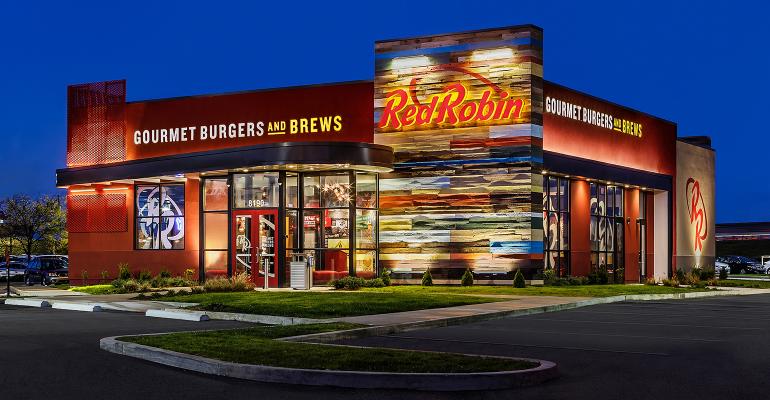Sales declines at shopping mall-based units of Red Robin Gourmet Burgers Inc. continued to dog the brand in the fourth quarter, executives said Tuesday.
Lynn Schweinfurth, chief financial officer of the Greenwood, Colo.-based casual-dining chain, said in a fourth-quarter earnings call that mall sales performance in the period was down about 5.5% compared to a 3.6% decline for non-mall locations.
“We continue to focus on improving the performance of certain challenged mall locations through rent reductions and marketing and sales-building strategies to improve profitability,” Schweinfurth told analysts, adding that the company was assessing each location and weighing possible exit strategies from troubled sites.
“We’ve seen this get worse now three quarters in a row,” said Denny Marie Post, Red Robin’s CEO and president, and the decline “has us looking with greater urgency at that element of our portfolio.”
Given the continued decline, Post indicated Red Robin would consider closing enclosed-mall units “where they make sense.”
Post said Red Robin has improved store-level economics by addressing high occupancy rates, securing savings of more than $2.5 million in cumulative rent last year.
“We are targeting additional negotiated savings in 2019 and may take more aggressive actions on our portfolio,” she said.
In addition, Red Robin is refocusing its value propositions to improve sales and foot traffic. For the fourth quarter ended Dec. 30, same-store sales declined 4.5% and guest counts fell 4.4%.
Post said that Red Robin over the past five years relied on its Tavern Double Burgers platform, priced at $6.99, to drive traffic, but that had created a drag on per-person check averages.
“We have since dialed back the number available at $6.99 to just two burgers, raising the price on the other Tavern Doubles,” she said. “As a result, Tavern’s mix has moderated from a high of 17% in Q3 to just over 14% in Q4, and we expect it to continue to move downward.” The company has turned to emphasizing its “Gourmet” line of burgers and began advertising its new El Ranchero burger this week.
Red Robin next week will begin advertising its $10 bundle, which is a dine-in-only offering with a selection from among three Gourmet burgers and includes bottomless fries and a bottomless beverage.
Red Robin had tested the $10 bundle as a lunch deal and expanded it to all-day in the fourth quarter in test markets, Post said.
In addition to stabilizing dine-in business, which was down 4.2 percent for the full year, Red Robin is also working to increase convenience in to-go options.
In the third quarter, Post said Red Robin will “launch a new online ordering system that is far more intuitive than the one we currently use” as well as improving its curbside service.
The company has grown its off-premise business from 5.4% of food and beverage sales in 2016 to 9.9% in 2018, Post noted. “We believe that it can double again in the next three years,” she said.
For the fourth quarter ended Dec. 30, which included asset impairment and other charges, Red Robin swung to a loss of $10.6 million, or 82 cents a share, from a profit of $8.8 million, or 68 cents a share, in the prior-year period. Revenues in the quarter, which included one less week than the same period last year, fell 10.8%, to $306.8 million from $343.9 million.
As of Dec. 30, Red Robin had 573 restaurants, with 484 company-owned and 89 franchised.
Schweinfurth said Red Robin is focusing refranchising efforts on about 100 existing locations and looks to increase its franchise mix up to 30%.
Contact Ron Ruggless at [email protected]
Follow him on Twitter: @RonRuggless





